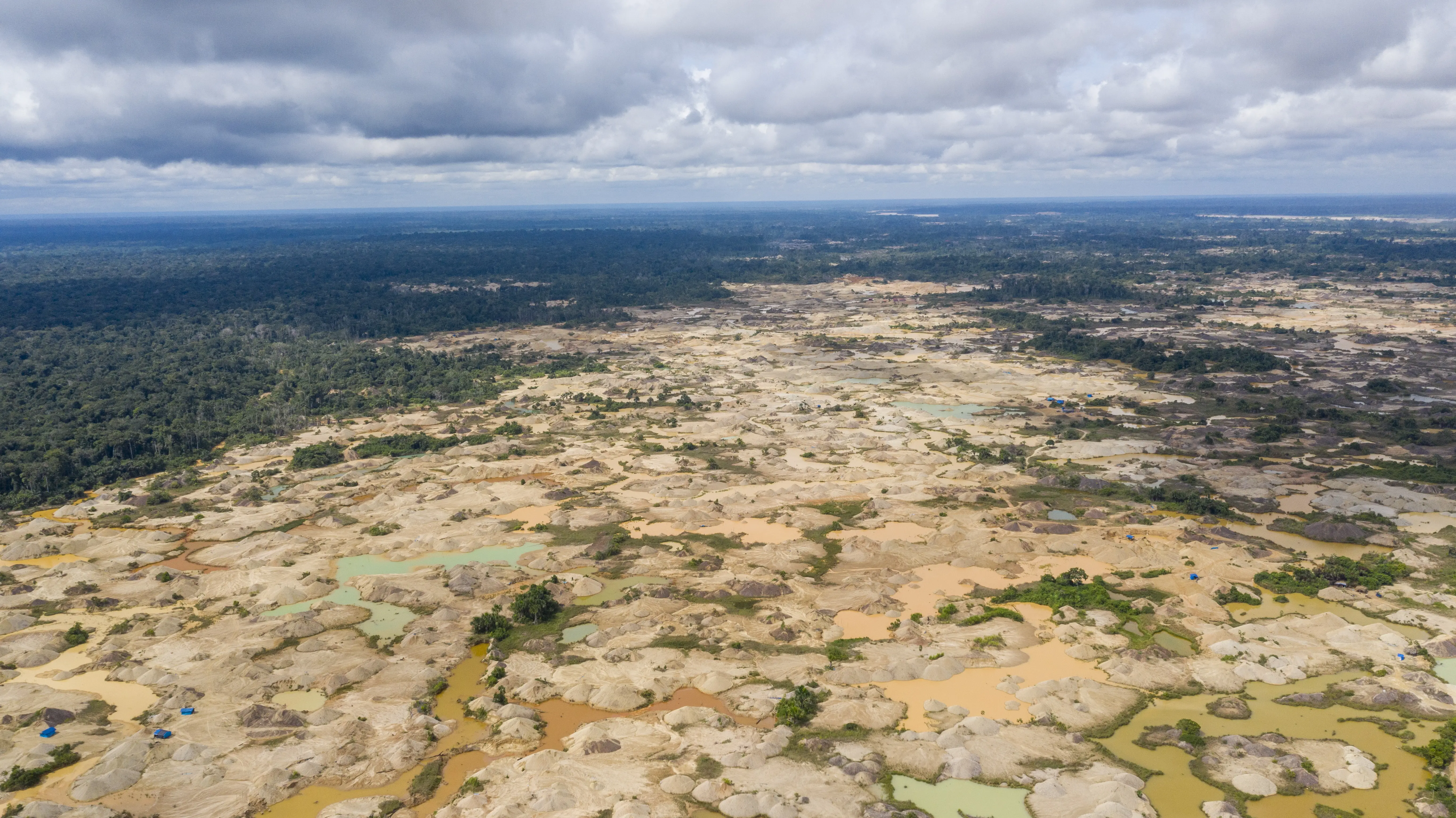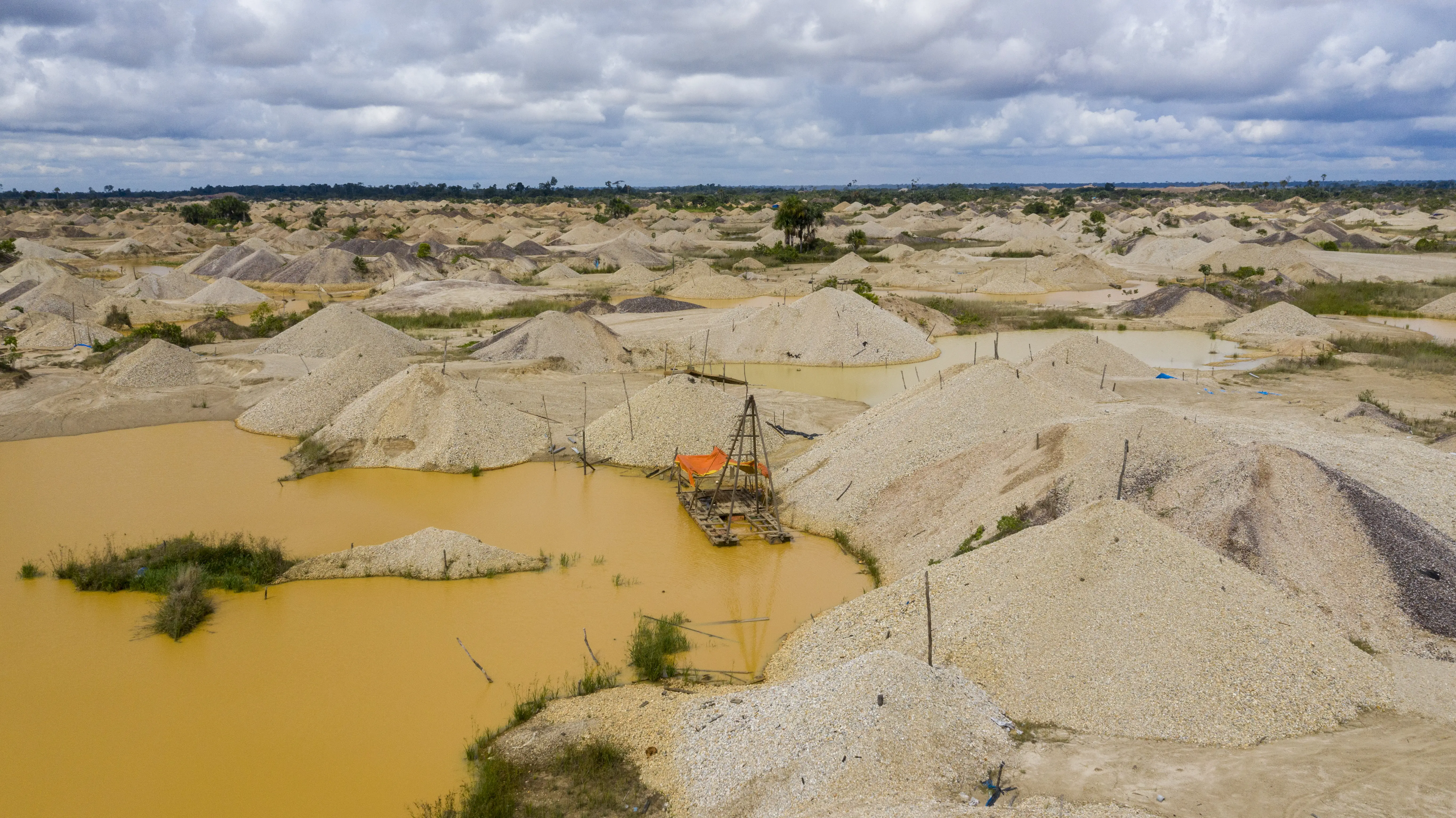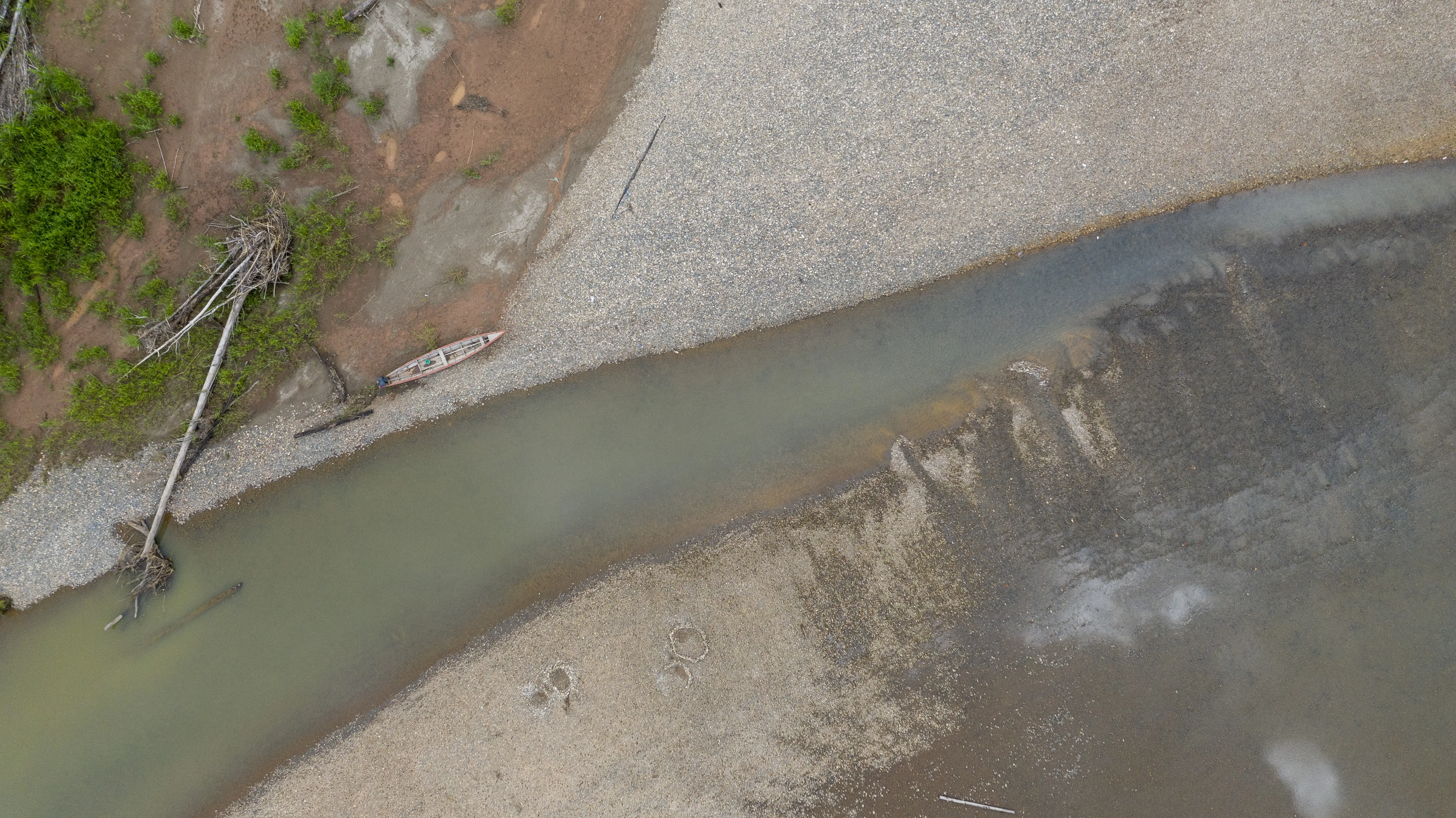This story excerpt was translated from Spanish. You may also view the original story on the Rainforest Journalism Fund website. Our website is available in English, Spanish, bahasa Indonesia, French, and Portuguese.

In the heart of the Peruvian and Bolivian rainforest, gold is amalgamated with illegal mercury produced in Mexico. The Harakmbut community has suffered the ravages of mining: contaminated rivers, deforestation, displacement, and oppression. Between mercury and gold lies a jungle at risk.
On any given day Larri Ihuizi Keontehuari carries a couple of gold nuggets in his pocket to sell them for 220 soles (US$60) per gram. A small man with an evasive gaze, at 37 he is the president of the Puerto Luz’s Harakmbut community in the south-eastern Peruvian Amazon. 500 people live in Puerto Luz spread over 62,000 hectares. This is one of the Indigenous groups that are allowed to mine gold without government authorization in the Madre de Dios region. They can invite non-Indigenous outsiders to do so as well.
Every day miners flock to Madre de Dios from all over Peru. Some authorized, some not, they collect bright yellow gold flakes from the Karene river, pack them into small piles and add a few drops of mercury to amalgamate the precious metal into solid pebbles. Three to seven grams are enough to yield one kilogram of gold.
Sheltered by thick vegetation, Puerto Luz boasts 500 inhabitants over 62,000 hectares. It is one of ten communities of the Amarakaeri Communal Reserve in the Manu province of the Madre de Dios region. To get there, miners spend upwards of US$100 for travel in two boats and three taxi vans.

As a nonprofit journalism organization, we depend on your support to fund journalism covering underreported issues around the world. Donate any amount today to become a Pulitzer Center Champion and receive exclusive benefits!
At the town’s entrance, a soccer field serves as the main square, surrounded by windowless wooden houses that lack plumbing and electricity, and creak in the humid jungle breeze. A sign on one house reads, “Even our critics share a dose of our fever.” In the undergrowth, stray roosters peck at discarded plastic bottles and ammunition cartridges. Pumping music hints at long nights of drunkenness, while an evangelical church watches over daytime activities.

Larri lives next to the church. His cracked hands remain clasped as he tries to explain how he came to lead the community. It was strictly by chance, something he never wanted nor requested, but now he is trying to figure out the responsibilities it implies. Unlike his predecessors, when asked about gold his eyes light up. “I am in favor of artisanal mining,” he says. But Larri’s face goes blank when asked about the problems the community faces; he ponders an answer while eyeing a shiny gold nugget on the table in front of him. With nothing to say, he directs his gaze at a light grey drizzle that begins to blanket the treetops.
In the lower part of town lives Jorge Tayón Keddero, who is in charge of the community’s security. At 70, he has been a witness to the erosion of his people’s cosmovision. He is imposing both physically and mentally, raising questions like, “What does man matter if there is no land to work? What does work matter if only others benefit? And what do other people matter if they don’t fight for the common good?” He then goes quiet; only to break the silence with tears.
Jorge does not agree with welcoming outsiders. He lives threatened by illegal miners and thinks, as he stares up a nearby ravine, that some people forget their roots when seduced by gold. For Jorge, there are alternatives to the selfish gold rush. He himself is planting premium-quality cocoa that has been prized in Belgium. “And it doesn’t require mercury or deforestation.”

Ruben Timelensuki, the Harakmbut president prior to Larri, agrees with Jorge. In the dwelling he shares with his large family, he keeps a small jar of El Español mercury next to his 42-inch television. Every now and then he wades into a stream and extracts a bit gold to earn a little cash.

Mercury in retrograde
Between 1932 and 1968, the Chisso Corporation dumped 80 tons of mercury used for acetaldehyde, a basic ingredient in food flavoring, in the Minamata Bay in southern Japan. After consuming mercury-contaminated fish, thousands of people and animals contracted what came to be coined as Minamata disease, a neurological illness that affects the senses and motor skills, and that inspired the ensuing Minamata Convention on Mercury, which bans the liquid metal internationally.
For millennia Mercury has been used in alloys. The Greeks used it in ointments and the Romans in cosmetics. Mercury was a Greek god, a winged and restless messenger, and namesake both of the planet—which, according to astrologers, lowers humans’ energy when in retrograde—and of the periodic table’s 80th element Hg, or hydrargyrum: liquid silver. Mercury is used to produce chlorine gas, caustic soda, batteries, switches, electrodes, and pesticides. Explosives are detonated with mercury fulminate and, initially, photographs were developed with mercury vapor. It is a bead of mercury that marks the temperature in an analog thermometer to indicate the presence of a fever; in the Peruvian jungle, however, it does not just mark gold fever, it also fuels it.

According to the Peruvian Ministry of Energy and Mines, half the nation’s gold is produced in the Madre de Dios region, which currently suffers a deforestation rate of 1,785 hectares—equivalent to 2,500 soccer fields—per month. In the heart of the jungle, “99%-grade” liquid mercury can be found at Delta 1, an outpost in a wasteland laid barren by loggers about two kilometers from Puerto Cruz.
Once covered by pristine jungle, today Delta 1 consists of half-built houses, exposed sewage systems, dogs sniffing through garbage, and rubble piled on muddy street corners, a settlement defined by miner’s ambitions, excavation equipment businesses and the discreet sale of sex and alcohol at prices comparable to those of New York City. It’s not without reason the miners laughingly call the outpost “Delta One.”
Surrounding Delta 1 are countless mounds of earth of about five meters tall, suction pumps, and chutes that break the tropical tranquility with the roar of industrial motors: a state-approved small-scale mining operation carried out on a large-scale with heavy-duty equipment. Control is scarce; 78% of miners granted claims by the government are individuals who never visit the mines but rather rent equipment to migrant laborers who come from all over Peru in search of earnings they could never amass in the country’s cities.

Of the government-licensed prospectors in Madre de Dios, 75 are authorized to purchase mercury. According to an investigation by the Center for Advanced Defense Studies, several prospectors were indicted for illegal mining, including the region’s former congressman and gubernatorial candidate, Eulogio Amado Romero Rodríguez. The consulting firm Macroconsult S.A. calculates that a third of Peru’s gold exports—bought mainly by Canada, India, and Switzerland—is extracted irregularly.
At Delta 1, a restaurant can also be a motel, a money transfer agency or a gold shop that only buys and doesn’t sell. Nowhere is the sale of mercury advertised, but upon inquiring, it is as readily available as rice or Inca Kola. A 100 g vial is priced at 60 soles (US$15), while a larger 500 g bottle goes for 270 (US$70).
Mercury prices are largely the same three hours away, at the La Pampa outpost near the kilometer marker 108 of the Interoceanic Highway, a site where clandestine graves have been uncovered with incinerated remains, where the NGO Capital Humano y Social (CHS) has discovered brothels with women subjected to human trafficking, and where, according to a study published in the science journal Nature, the levels of mercury contamination are similar to those of industrial zones in China.

Manzanillo—La Paz—Puno
A year after adopting the Minamata Convention in 2015, Peru began to impose a mercury ban. In neighboring Bolivia, mercury imports rose in the same proportion that they fell in Peru.
The chemical engineer Vilma Morales, who for ten years dealt with mercury trafficking as part of Peru’s Ministry of the Environment, affirms that mercury imported by Peru was redirected to the country’s southern neighbor in the wake of the ban. “In 2012 Bolivia imported 34 tons; in 2016, 230 tons. Peru, on the other hand, registered no mercury imports in 2016.”
According to official data, in 2020 Bolivia imported 160 tons of mercury for US$7 million, more than any other country in the world. Half the imports originated from Mexico, the world’s second-largest mercury producer behind China, while the rest came Russia, Tajikistan, Vietnam, and India.
Once in Bolivian territory, the mercury’s tracks disappear. But, while it can’t be traced, Vilma Morales assures that “the best hypothesis indicates that the mercury enters Peru from Bolivia via the border town of Desaguadero.”

Oscar Campanini, an expert in extractivism at the Bolivian Center for Documentation and Research (CEDIB) argues that data he collected from Bolivian mining cooperatives shows the country consumes only 60 or 70 tons of mercury per year. “The rest is smuggled.”
Three Bolivian companies were responsible for half the nation’s mercury imports in 2020: Paloan, Insumer Bolivia, and Juan Orihuela Mamani Import-Export. Some Peruvian importers are also listed in Bolivia such as Surfworld, which is based in Lima and managed by Claudia Selene Ramírez Tapia, but has a Bolivian branch in Sapocachi called Importaciones Ramirez Tapia. Both entities share the same email: [email protected].
Official records indicate that, of the 26 Mexican companies that exported mercury to Bolivia in 2020, three stand out: the Querétaro Miners’ Union, Ivfresou, and Productos Mineros RT, which sent at least 56, 49, and 19 shipments respectively from the port of Manzanillo on Mexico’s Pacific Coast bound for Arica, Chile, in transit to La Paz.
Bolivia adopted the Minamata Convention in 2013 but never complied with its mercury ban. In March 2022, Marcos Orellana, the U.N. Special Rapporteur for Toxic Substances, affirmed that in Bolivia he sees “not a reduction in the use of mercury but a concerning increase in smuggling.” The Inter-American Commission on Human Rights (IACHR) has asked the Bolivian president Luis Arce to explain “the increase in mercury imports, which have quadrupled in the last decade.” Mercury is key for mining the nearly US$2.6 billion in gold that Bolivia exported in 2021, which was extracted mainly from its Madidi National Park and surpassed all the country’s other exports, including fossil fuels.
Legal trafficking
The best-known brand of mercury is El Español, distinguished by its logo of a bullfighter taunting a bull, available in both Peru and Bolivia. Owned by Alfredo Triveños—convicted of mercury trafficking in 2016 four years after receiving the “Best Peruvian Company of the Year” award—the brand’s label reads, “With God everything; without him, nothing.” On his website, Triveño shares memes with phrases such as “there’s a huge difference between giving up and knowing you’ve had enough.” In Lima, Triveño’s company appears registered as a tourism agency, although its email address, [email protected], clumsily exposes the façade.
Mercury vendors take advantage of El Español’s fame by reusing bottles or counterfeiting labels. The metal is so dense that half a kilogram fits snugly into a small 40 ml jar. Another brand, “German mercury” is red in color and its bottle bears skull emoji above the words “suitable for nuclear tasks.” But like El Español, which has nothing to do with Spain, “German mercury” is pure marketing; it is the same as any other, just with red dye.
“Success is not measured by what you achieve, but by the obstacles you overcome,” Oscar Gandarillas, a tall and chubby man in his fifties posted on his Facebook account. Oscar lives in La Paz, follows the Bolívar soccer club, and owns the hardware importer Handyman.
He likes mining, he follows the Chinese machinery company Xinhai Mining on social media, and he watches videos showing the Chinese processing gold in Tanzania. Oscar doesn’t do anything illegal: he’s not a trafficker because anyone can buy and sell mercury in Bolivia in hardware stores or via online platforms like Facebook Marketplace and Mercado Libre without authorization and without ending up in jail. Recently he posted, “El Español mercury has arrived, it’s the original” for 850 Bolivian pesos (US$123) per kilogram. His other posts specify, “Silver mercury, a Mexican original.”

Contraband
According to a BBC article, the former prosecutor Karina Garay is “Wonder Woman.” The colonial-style living room of her home near the center of Cusco is filled with her grandparents’ collection of religious oil paintings. “Since I was a girl, I have been interested in both social awareness and environmental protection, and I have confronted the powers that ignore them.”
Karina is short, but with a strong voice and precise words. She’s jovial when talking about her nickname but gets serious when detailing how difficult it was for her to earn it. As a prosecutor, she persecuted all kinds of traffickers as was declared Peru’s “woman of the year” in 2020 by then President Martín Vizcarra, who spoke of “her courage and her commitment to the legitimacy of the judiciary.” But to avoid the traps of corruption, she says, she was forced to resign.

After seizing mercury in several operations, she assures that it “comes from Mexico” and that, after passing through Bolivia, the metal enters Peru hidden in yogurt cups. Bolivia’s best known dairy producer, Tiwanaku, promotes the motto “for a healthy planet.” Additionally, Garay adds, mercury enters the Peruvian city of Puno via the border town Desaguaero hidden beneath the traditional skirts of Andean women. “Poor cholitas, usually they don’t even know they’re being used as mules.”
There are several border crossings between Bolivia and Peru. Desaguadero to the south is the busiest and most commercial, but another crossing 900 km north, near the outpost of San Lorenzo in an area deforested by lumber industries, consists of little more than a small green building at the end of a fork in Route 30C.
In the middle of a subtropical forest of reddish soil, the building acts as a customs house and security checkpoint. Edwin Pari, born in Tacna 25 years ago, is the building’s policeman and landlord. Accompanied by Cuto, his mutt puppy, he sports a Juventus T-shirt, cutoff jeans, and canvas sandals.
About a hundred meters behind that checkpoint lies an imaginary borderline among the tall, dense foliage, two tipped-over traffic cones and a modest meter-high monolith that reads “Bolivia.” This border presents two problems: deep mud and traffickers. According to Juan Carlos Sotomayor, a police officer who helps Edwin by patrolling the area on motorcycle, this is a route for human trafficking and contraband.

Reporting was made possible thanks to the 2022 GRID-Arendal Investigative Journalism Grant and support from the Pulitzer Center’s Rainforest Journalism Fund.









